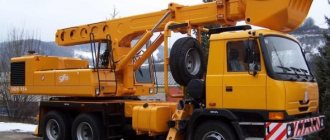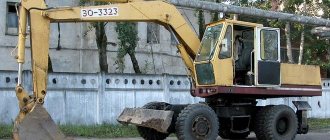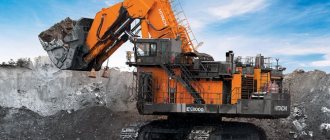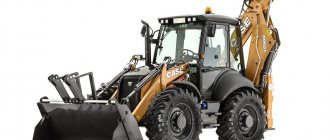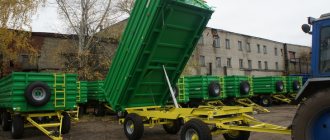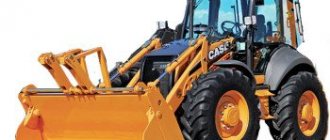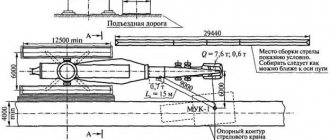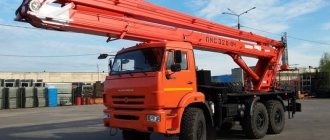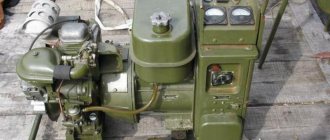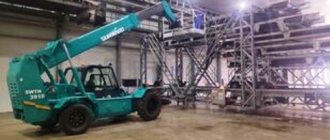Purpose of the walking excavator ESH-15/90
The walking excavator ESH-15/90 is designed for excavating soils from categories I to IV of hardness, inclusive, during stripping operations using a non-transport system with laying rock into the goaf or on the side of the open pit, while soils of categories III and IV must first be loosened by blasting.
The walking excavator ESH-15/90 can be used in open-pit mines in the coal industry, ferrous and non-ferrous metallurgy, the building materials industry, as well as in the construction of canals, irrigation systems and various hydraulic structures.
The walking excavator ESH-15/90 is a reliable, highly productive and maneuverable machine, which, thanks to its low operating pressure on the ground, can work on soft soils.
Information and analytical publication TECHNOmagazine
Creation of SE-3
In the 1920s, the romance of socialism had quite visible outlines.
Young people of that time saw it in strong and smart machines, capable of taking on all the hard work and freeing a person for ideological growth and self-improvement. And the fact that all these strong and smart machines were created not in the country that undertook to build socialism, but in the countries of the enemies of socialism, did not mean anything. Some young romantics dreamed of a worldwide revolution, as a result of which socialism would be established throughout the world, and the production of strong and smart machines would thereby transfer to the socialist system. Other young romantics dreamed of creating these machines in their own country. Among them, who dreamed of creating strong and smart machines in our country, was a student at the Novocherkassk Institute of Water Resources, Boris Ivanovich Satovsky, a native of the Georgian city of Kutaisi, without exaggeration, the founder of the domestic excavator industry.
Boris Ivanovich Satovsky, born in 1929, attended three courses at the North Caucasus Institute of Water Resources and Land Reclamation. At Uralmashplant since 1936 - in design work. Since 1945 - head of the design department bureau. 1931–1936 – worked as an excavator operator, an instructor at the excavator fleet, and as a designer at the All-Union Design and Technical Office for Excavator Manufacturing.
Before the war, he was involved in the design of excavators of various models. During the war, he was a tank assembly technologist who created advanced technology for unit assembly, which made it possible to significantly increase the production of combat vehicles.
In 1944 he stated: “The design development and production of prototypes of excavators should begin at this time.”
SE-3 is an exceptionally successful excavator model: relatively simple and technologically advanced in production and at the same time corresponding to the best world standards. Its name is deciphered differently: some - “rock excavator”, others – “electric rock excavator”, others – “Satovsky excavator”. But this is probably not that important. The main thing is that the mass production of these machines at Uralmash played a huge role in fulfilling the plans of the post-war five-year plans: in the development of many mineral deposits, the construction of the largest hydroelectric power stations, and the laying of shipping and irrigation canals. These machines were also highly appreciated abroad - they were used in the construction of the high-rise Aswan Dam and irrigation structures on the Tigris and Euphrates rivers.
The triumph of Satovsky’s design thought was the creation of the country’s first powerful walking excavator, which since 1950 has been working on the construction of the Volga-Don Canal. And then, under his leadership, a new branch of heavy engineering was created at Uralmash - the production of walking excavators for the mining industry, high-performance draglines with booms 90-100 m long.
For 25 years, Satovsky headed the design department of mining and blast furnace engineering at Uralmashplant, where, along with mining excavators and draglines, projects for the world's largest sintering and roasting machines were created, which made it possible to raise the country's ferrous metallurgy to a new level. At the same time, this division created equipment for the world's largest blast furnaces and highly efficient crushing and grinding equipment.
Laureate of the Stalin Prize, III degree for SE-3 (1948), and I degree for creating the design of the walking excavator ESH 14.65 (1951). Doctor of Technical Sciences (1966), without defending a Ph.D. thesis.
He first encountered an excavator, this dream come true of the romanticism of socialism, during his student internship in the Kuban, where several American-made excavators were working. Student Satovsky became so fascinated by machines that by the end of his internship he worked on one of them as a machinist, and then as a mechanic.
Moreover, after practice, he simply left the institute and went to Leningrad, to the only design bureau for designing excavators, headed by N.G. Dombrovsky. Here he participated in the development of the first domestic excavator, and then, as an employee of this bureau, he came to Uralmash in 1936 and got involved in the development of a prototype of this machine, conquered everyone with his acumen, tenacity, extraordinary thinking - in a word, with what would later be call it Uralmash character. He received an invitation to stay at Uralmash and began working on his own excavator project, which promised to be unique at that time.
The war put all peaceful plans on hold for a long time. Only in 1944, after lengthy and difficult discussions by a specially created commission about the development prospects of the plant and its products, excavators were included in the production range. The difficulty of making such a decision was that the government of the country, and in particular the People's Commissar of Ferrous Metallurgy Tevosyan, seriously feared for the fate of the plant's strategic production line for the post-war years, large rolling mills. But there was a war, and in the end, wartime thinking won out - the plant would produce both mills and excavators. True, to make such a decision, Boris Ivanovich and the plant director Muzrukov, who supported him, had to put in a lot of effort and energy, and present the most convincing arguments and calculations.
B.I. Satovsky headed the design bureau of mining equipment, which employed such prominent design engineers as V.I. Fedorov, V.R. Kubachek, A.P. Borisikhina, S.K. Borisov, V.L. Raskin, V.I. Zykov, A.B. Vernik, Yu.G. Egoshina.
The first Uralmash excavator left the workshop under its own power in May 1947. This moment was filmed by all-Union newsreels - and the event was worth it. In the development of the excavator, design solutions were used that greatly simplified its maintenance and repair, while simultaneously increasing its power. In this regard, Uralmash designers were two decades ahead of foreign companies.
The first-born turned out, as people would say, with one more “talent” - his “hand” turned out to be one and a half times stronger than what was originally intended. In its “palm” it could hold not three cubes, but four and six tenths, and therefore in 1955 it was modernized and named EKG-4.6 (a quarry excavator, tracked, with a bucket volume of 4.6 cubic meters).
And in another situation involving an excavator, the rhythm and thinking of wartime affected. The production of a prototype was still underway, and in August 1946 the plant began assembling the first three machines, the production of which was increased to 120 in 1948.
The first SE-3 cars went into production and immediately brought praise, and then orders from abroad. The People's Republic of China began to buy them, then Finland, Egypt, Syria, Iran, India, Turkey, Mozambique, Vietnam, Poland, Mongolia, Iraq, Romania, Yugoslavia... And in total, Uralmash gave the country and the world 12.5 thousand cars of this brand and its modifications : ECG-4.6 and ECG-5. They work reliably in all climatic conditions and at all latitudes of the continent. It would seem, what else is needed? But officials from the Ministry of Heavy Machinery demand: “Reduce the metal consumption of excavators, remove alloy steel grades!” At one of the meetings B.I. Satovsky said: “I won’t make excavators out of shit!” - and such was his authority that they left him behind.
Then there was a step
But in B.I.'s dreams Satovsky and his comrades were far ahead. In their dreams, they approached their walking excavator. Boris Ivanovich, like the management of the plant, understood that this would determine the fate of Uralmash for many years as the flagship of the industry, confirm the class, high level of all services of the plant - the design bureau, welding, metallurgical, mechanical, assembly shops, the high professionalism of the workers. Others understood this no less than the Uralmash residents. Only others didn’t have Satovsky. That is why, when the government at the beginning of 1948 raised the issue of creating the production of walking excavators and the Ministry of Heavy Engineering began to lean towards the Kramatorsk Machine-Building Plant, the fighting “Satov” character again played its role. Boris Ivanovich and his associates proved to the ministry that the Uralmash version was beneficial for the country.
“Okay,” they were finally told. “Okay, but...” and, without flinching, they set the work period at 8 months, although even for experienced design bureaus it was set at least three years, and the Uralmash workers had to start work of this kind for the first time. Perhaps the government thought that the Uralmash workers would refuse. But it turned out differently.
“Calculations for electric motors alone will take several months,” Satovsky began to count. – The calculation and design of the boom will take the same amount of time, and the platform will take the same amount of time. And in total there are more than twenty thousand parts in the car. Well then! - and he again makes a truly “Satov” decision. – We will carry out the design simultaneously in several groups – each with its own profile!
And he didn’t care at all that no one had ever designed a car like that - this is not a railroad bed, where the sleepers, rails and the track itself are the same everywhere. This is a complex system where a small error in the calculation of one part can ruin the entire machine.
- Nobody did it, but we will do it! - he decided. – And in order to meet the deadline, to gain time, we will do it without a preliminary design. Here are the main parameters of the excavator: bucket volume 14 cubic meters, boom length - 65 meters, total weight 1100 tons.
One can only guess about the feelings experienced by Boris Ivanovich’s colleagues when posing such a task. And one can only be amazed at the audacity with which they trusted their leader. But audacity was audacity, and the work required, first of all, enormous knowledge, physical and spiritual stress. I had to work, as they say, twenty-five hours a day and use for inspiration what, it would seem, by its very essence was never intended for this - for example, ballet. Jokes aside, but according to engineer H.A. Vinokursky, who was responsible for the design of the arrow, could not find a solution in which the arrow would meet the requirements of being strong and light. Found the solution by H.A. Vinokursky at the performance of Swan Lake. The light, graceful steps of the ballet dancers, as strange as it may sound, gave him the idea: after all, the arrow should be made from pipes of a light and elegant material in its own way, and all elements that work in tension should be fastened with a system of steel cable cables.
Or another example - the production of a 150-ton turntable. There was not even a crane in the workshop to lift such a colossus, and, above all, it was necessary to bore holes in it with an accuracy of fractions of a millimeter. A group of technologists led by A.A. Lyubimov, with the participation of the chief engineer of the plant S.I. Samoilova, suggested not carrying the workpiece to the machine, but the machine to the workpiece. And so they did.
And if we are talking about technologists and workers, then it should be said that without them the most brilliant insights of the designers would have remained on paper, and more examples of their creative and selfless attitude to work should be given. Even while working on SE-3, engineers I.S. Gusev, I.S. Veretennikov, A.S. Ananyin, O.F. Zubarev used methods of casting and molding of parts that had not been used before. Engineer N.M. Leleko designed, and Yu.G. Egoshina created new high-performance welding stands. For the introduction into the production of machine molding of a multi-ton tracked frame measuring five by five and a half meters, engineers A.T. Taleisnik, Yu.P. Shkabatura, N.A. Spravtsev, N.A. Malyshev were awarded the Stalin Prize. No statistics will remember how many castings were rejected until the foundry workers achieved the required quality of castings for excavator buckets. It is equally impossible to imagine the torment of the assemblers, who at the final stage of creating an excavator had to deal with all the flaws in the designers’ plans, the inventions of the technologists, and the imperfections of fellow mechanics, turners, and gear cutters. And how the worker Turuntsev saved the situation! It would take a month to turn the boom, if there was only one machine at the factory suitable for working with such dimensions. No one in the eight-month construction mode could give such a period. And then Turuntsev re-equipped his machine so that all boom sections were processed in less than a week.
But, probably, the most fundamentally new solution was the decision to make the excavator move using hydraulics, instead of the commonly used but unreliable system of eccentrics on a massive shaft.
B.I. Satovsky divided the step of the excavator into separate moments: lifting the machine body, pushing out ski supports, moving the body, and so on. The idea came to him on the street. His gaze accidentally lingered on the man walking in front with two suitcases. The suitcases were of different sizes and different weights. But the man walked straight.
- Why? - asked the designer Satovsky and answered, - yes, because when a person walks, different muscle groups work at each moment, and not all at once. What if you make the excavator move in the same way?
This became possible when engineer T.E. Isaev proposed his own hydraulic walking mechanism. Only in this case can the “muscles” of the machine be autonomous and work consistently. Timofey Emelyanovich himself came up with the idea of using hydraulics when walking an excavator in August 1945 during a business trip to Karpinsk. Water flowed in fountains from the leaky hydrant sleeve. And although he, like all of us, had seen this more than once, the idea to calculate the pressure force from the height of the fountains came only then. When calculating, Timofey Emelyanovich was amazed - but such a pressure of water may well be enough to move huge machines if the water is enclosed in special devices. Together with B.I. Satovsky, he thought out a system of such devices and thought out its “leader” - a special device that consistently and timely includes the elements of the system. The “leader” was called the autopilot.
By the scheduled date, a machine with more than twenty thousand parts, some of which weighed more than a hundred tons, with ten kilometers of electrical wires and four kilometers of pipes, was designed and assembled. Tests began, which brought further problems. When the engine was first started, the electrical system failed. They rebuilt it - the hydraulics failed. Here we had to take a hard time. It got to the point that Satovsky and Isaev climbed onto walking skis from both sides and manually forced the mechanism to move. First one shouted: “Open the valve!” Then another shouted: “Now you open it!”
So gradually, according to the popular joke, “where with affection, and where with lubricant,” they taught the excavator to walk.
The team of creators received a torrent of praise. Leaders, specialists, and the press congratulated them on their victory and called the first Soviet walking excavator a technical miracle. Even Pavel Petrovich Bazhov came to look at this miracle, walked around, poked his skis with a stick, stood aside, looked at the whole machine and made a conclusion: “Tsar Machine!”
It seems that only one engineer, Satovsky, was not happy with his brainchild. “The excavator is still working poorly... We need to draw up a report in which not only to enter the problems, but to analyze them in detail,” he writes to himself as a note at a moment of general rejoicing, noting, however, that the reserve of the excavator turned out to be solid - the boom could be increase from 65 meters to 75, and the technical council soon agreed to this. So the first-born quite quickly changed its name - instead of ESH-14.65 it began to be called ESH-14.75, that is, it began to be called “a walking excavator, with a bucket volume of fourteen cubic meters and a boom length of seventy-five meters.”
The very first copy of the machine was sent to the Volga-Don, and it worked there until 1979, for thirty years, breaking all records for the longevity of such machines. It should be said that at the same time in England they were designing their first walking excavator, and it was designed from 1947 to 1951. Only the boom was installed there for a year and a half. During its installation, Uralmash released and sent to work three walking excavators, one of which even managed to remove more than two million cubic meters of soil. At the same time, the ESh-14.65 boom turned out to be one and a half times lighter than the English one and was assembled in a matter of days.
March 13, 1951 for ESH-14.65 B.I. Satovsky, V.R. Kubachek, H.A. Vinokursky, T.E. Isaev, D.A. Yasenev, S.K. Borisov, A.A. Lyubimov, S.A. Gorelyshev was awarded the Stalin Prize of the first degree.
Next Steps
In April 1965, the modernized ESh-15.90A was installed in the Chkalovsky quarry of the Ordzhonikidze Mining and Processing Plant, which, in fact, became a new unique machine in the family of walking excavators. And at the end of the 70s the ESh-40.85 appeared. The machine was created under the guidance of designers V.L. Raskin, S.G. Ziganshina, H.A. Vinokursky. One of the most fundamental innovations was the replacement of the cable-stayed openwork boom with a rigid, triangular one. According to V.L. Raskin, convincing his colleagues of such a replacement turned out to be very difficult. Everyone got used to the “lace” of cable-stayed booms and did not want to give them up, even though the ends of the steel cables rusted, they had to be replaced every 5-6 years, and each replacement resulted in long downtime. Many years of subsequent work of the modernized ESh-15.90A and other Uralmash machines showed that they are so productive and reliable that they remain the plant’s main product in this class of machines. Even foreign experts were forced to admit their superiority. When defending the modernization project, someone from the technical council asked V.L. Raskin, how the ESh-15.90A holds up in comparison with foreign machines. V.L. Raskin pointed to posters depicting foreign and our excavators. One glance was enough to see that ours are graceful, like ballerinas, theirs are heavy and cumbersome, like sumo wrestlers. Experts say that the more elegant the design, the more perfect it is.
The largest excavator was the powerful walking excavator ESH-100.100, which was created and began work at the Nazarovsky coal mine in June 1980. Its bucket could fit a small two-room apartment. Its weight was 10.5 thousand tons. It was created by a team of designers under the leadership of V.L. Raskin, and the most important part - the hydraulic walking system - was designed by engineer M.A. Kazarinova, student of B.I. Satovsky and T.E. Isaeva. After the launch of the first walking T.E. Isaev began to praise often, and Margarita Alexandrovna had to replace him on business trips to install machines.
She had been leading a group of hydraulics at a walking excavator design bureau for many years when she was tasked with developing a walking mechanism for the giant 100.100. Chief engineer of the project V.L. Raskin immediately said that a new hydraulic walking installation would be required here. And Margarita Alexandrovna began to work on it. Thoughts and calculations resulted in dozens of filled notebooks - sketches, formulas, sketches. The decision came when she came across a magazine describing radar. It was there that she found a description of a mechanism whose idea could be used in a walking device. And Margarita Aleksandrovna seeks a business trip to a top-secret military plant that produces these same radars in order to study the operation of the mechanism for their reversal.
Without going into details, let's say she came up with her own walking mechanism, not the same as that of teacher T.E. Isaeva. She came up with a different mechanism for moving skis and the support base. During the discussions, many experts did not believe her. At the final council, the chief engineer of the plant, Nikolai Ivanovich Ryzhkov, said: “It’s an interesting idea. But tell me honestly, Margarita Alexandrovna, will he walk?
He began to walk well, although he had to suffer quite a bit. And not only M.A. Kazarinova. For example, when it became clear that the manufacture of parts for this mechanism would require grades of steel that had not been produced at the plant before, the metallurgist Shevelev conducted dozens of experimental melts until he achieved the required quality of the metal. And the welding engineer Kubachek, the son of Professor Kubachek, disappeared in the workshop for days until he received cylinders for its mechanisms, welded by him using a special technology. Future director of the plant M.I. Matvienko, then still the head of the mechanical workshop, sometimes spent the night in the workshop, making sure that the machine operators achieved the required cleanliness of machining the cylinder cavities. And when all the parts of the excavator were ready, Kazarinova herself spent almost a year installing it.
By the way, a completely unthinkable incident is connected with the launch of the giant. At the end of the installation of the excavator, everyone suddenly realized that the place where the railway workers unloaded the giant’s parts from the trains and where it took about three years to assemble it was several kilometers away from the quarry. The question arose: how to get it there? Disassemble, transport and reassemble again? But this is work for many years to come! And someone said: “He’s a walker!”
And the excavator came under its own power to work in the quarry - such a safety margin was built into its hydraulic walking system.
Everyone understood how great this woman’s contribution was to the creation of ESH-100.100. Therefore, the plant included her name among the first on the list of candidates for the USSR State Prize. In November 1984, a large group of specialists were awarded the USSR State Prize for the creation of ESh-100.100 and for the implementation of transport-free systems for developing coal deposits on their basis. Among the laureates were Uralmash residents: project manager V.L. Raskin, engineers A.V. Koksharov, B.G. Osipov, M.K. Brusnikov. But named after M.A. For some reason, Kazarinova was not among the laureates.
In 1984, Uralmash began designing a unique walking excavator ESH-100.125. The excavator could then become the largest in the world. But the design was soon suspended.
In July 1997, a presentation of the project of the new Uralmash walking excavator ESH-40.100 took place, the contract for the production of which was concluded with the largest coal enterprise in Russia, JSC Vostsibugol. This machine, created on the basis of the ESh-40.85 excavator, embodies the best ever created by Uralmash and generally domestic specialists in the field of heavy excavator construction.
In the spring of 2001, Uralmash, together with the Japanese company Itochu Corporation, won a tender for the supply of an ESH-25.90 walking excavator to Mongolia.
Sergey Ageev
A little history
(I.I. Potapov. “Thirty years on the presidium”):
“Once upon a time, American industrialists arrived at Uralmash, led by one of the representatives of the Ford family. Seeing the slogans: “Viva Fidel!”, Ford turned to me: “Why is there no slogan “Viva Ford!”?
I answered him jokingly:
– If Mr. Ford supports our ideology and cooperates with us, then there will be much more greetings addressed to him than to Castro.
He burst out laughing:
– Oh, you are a good propagandist.
The Americans did not hide the fact that they liked the plant, especially the block of workshops for welded machine-building structures. They, in my opinion, sincerely said: “There are only a few such factories in the world that produce high-quality and wide range of products.”
In the evening, the chief designers of UZTM, Doctors of Technical Sciences Georgiy Lukich Khimich and Boris Ivanovich Satovsky, took part in a conversation with them. These people were famous in America, especially Satovsky. The Americans admired the courage and originality of thought of our designers, including Boris Ivanovich, in the design and construction of walking excavators. Over a glass of wine, one of the guests said this:
- Mr. Satovsky, we invite you to America. We will immediately provide you with your own country house, a car, a high salary, and create all the conditions for creative work.
Remembering this episode today, I imagine how the eyes of some specialists and scientists would light up: “a stunning prospect!” And then I froze at the unexpected proposal: what would our Satovsky answer?
“Thank you,” Boris Ivanovich responded simply. – I am satisfied with working at Uralmash. I have excellent living conditions, a good salary, a country house and a Volga car.
He was not disingenuous at all, he had everything listed, another question is how comparable everything is, but then the comparison went differently, and the Americans were unable to understand it - different mentalities. Different upbringing and life.
Author: TECHNOmagazine
Share
Technical characteristics of the walking excavator ESH 15/90
| Bucket capacity, m3 | 15 |
| Boom length, m | 90 |
| End load, kN (no more) | 420 |
| Average ground pressure, kPa: when working while walking | 98 147 |
| Movement speed, m/s | 0,055 |
| Maximum radius of digging and unloading, m | 76,5 |
| Maximum unloading height, m | 37 |
| Maximum digging depth, m | 45 |
| Excavator weight, t | 1300 |
| Radius of rotation of the tail part of the turntable, m, | 17,5 |
| Excavator width on skis, m, | 18,06 |
| Body width, m | 17,2 |
| Body roof height above ground level, m | 12,5 |
| Clearance under the turntable, m | 1,45 |
| Base diameter, m | 12,3 |
| Ski length, m | 15,0 |
| Ski width, m | 2,4 |
A little history
In the Soviet Union, the first steps to develop walking machines were taken in the 30s of the last century. Mass production of equipment began in the early 50s, when the country was in great need of resources. On the territory of the Soviet Union, there were two enterprises that specialized in the production of this type of equipment. One was located in Novokramatorsk, the other in Yekaterinburg.
Considering that the same models were produced, it was possible to determine the manufacturer by the index. For example, Novokramatorsk units were designated as follows: ESH-14/50. The name of the Ural technology was written with a dot: ESH 11.75.
A prominent representative of that time was the walking excavator ESH 10 70. This is a full-rotary type machine designed to work with soils up to category 4 of complexity. This excavator belongs to the dragline category, that is, the bucket is attached to the boom using cables and sinks into the rock under its own weight.
Based on this model, several modifications were created. It is worth noting that ESh-10/70 is still used today. Here are the technical specifications of the base model.
| Weight | 695 tons |
| Claimed performance | 756 cubic meters/hour |
| Bucket volume | 11 cu. m. |
| Boom length | 70 m. |
| Depth of excavation | 35 m. |
| Covered radius | 65 m. |
| Permissible unloading height | 27 m. |
Subsequent models became more productive. For example, the capacity of the bucket has increased to 40 cubic meters, and the volume of work performed has increased proportionally. The main structural components are made of low-carbon alloy steel, which ensures the reliability and durability of the structure.
Walking
The most powerful vehicles with Dragline equipment weigh tens and hundreds of thousands of tons, and when installed on tracked (and even more so wheeled) chassis, the load on the site becomes too great. To avoid this, the support area of the excavator was maximized, and its movement was set to a “walking stroke” with a hydraulic drive (for some machines a crank-lever or mechanical drive is used). One “step” occurs in two stages:
When stationary, such a machine stands on a wide support platform.
If movement is necessary, the weight of the excavator is transferred to special “skis” (“shoes”), controlled by pairs of hydraulic cylinders. He moves one “step” and sits down again on the support platform.
By performing these two operations alternately, the Dragline can move at a speed of no more than 100 meters per hour. This is enough for a slight change in its location relative to the quarry being developed.
IMPORTANT! If it is necessary to transport walking excavators over distances of up to 80 km, heavy-duty transporters are used, and for longer transportation the machine must be disassembled and transported in parts.
At the moment, it is “walking” dragline excavators that have become most widespread and popular, pushing tracked and wheeled models into the past.
Device "ECG 5A"
This mining walking excavator is designed for unloading soil. The boom on it is installed with a total length of 60 meters. At the same time, buckets for it are suitable for different capacities. The most common is the model with a capacity of 10 cubic meters. meters. The operator can adjust the angle of the boom. In this case, it rotates 360 degrees. The walking running equipment of the EKG 5A excavators consists of a set of rotation mechanisms, as well as a drive. The model’s platforms are capable of withstanding a maximum weight of 600 tons. The theoretical performance parameter of the device is at the level of 620 cubic meters. meters per hour. The lifting force of the boom depends on the set degree.
The depth of the EKG 5A excavator is exactly 35 meters. In this case, the unloading radius is 66 meters. The clearance above the rotating base is quite large. Separately, it should also be noted the significant travel width at 13 meters. The body of the presented excavator is 10 m long. For light soils, the EKG 5A modification is excellent.
Excavators of the "ECG" series
Excavator buckets have a capacity of 10 cubic meters. meters. The length of the arrow in this case is 70 meters. The driver has the ability to adjust the angle of inclination. At the same time, it rises by a maximum of 30 degrees. In this regard, the lifting force of the excavator changes. The maximum can be 500 kN. At an angle of 25 degrees, the cycle duration parameter is at 50 s. The theoretical productivity of the modifications is 680 cubic meters per hour of continuous operation. You can meet EKG excavators quite often in quarry work. They can only be used on light hard rocks.
Record holders
Considering the characteristics and power of the machines, a completely legitimate question arises: what is the largest walking excavator in the world?
There are two models vying for this role:
Today, the largest walking excavator in the world is considered to be the ESH 65.100. This model works at the Mugun coal mine in the Irkutsk region. The weight of the machine is 4,500 tons, the bucket holds about 40 tons of coal ore. It is worth noting that the daily productivity of this model is about 30,000 cubic meters. coal
Features and types
Such excavators received their name because of the special design of their self-propelled chassis, which is fundamentally different from the traditional wheeled and tracked propulsion units usually used on this type of special equipment.
Such a mover is a special support plate (base), on which a rotating platform with excavator equipment of various types and two to four support skis (shoes) controlled by powerful hydraulic cylinders are fixed (depending on specific models). In a stationary (working) state, the base plate rests on the ground, providing a stable base for the machine. To start moving, the support skis rise up, move forward and rest against the ground. In this case, the weight of the excavator is transferred to them, as a result of which it, together with the base plate, rises above the surface of the earth, moves forward a certain distance and lowers, again resting the base plate on the ground. Thus, the excavator seems to take one step. Then the entire cycle is repeated the required number of times, ensuring the machine moves forward the required distance.
The category of walking excavators includes two main types of such special equipment:
- Single-bucket excavators with dragline equipment (draglines).
- Rotary bucket excavators.
- The main difference between these two types of excavators lies in the special design of the working excavator equipment and the principle of their operation when excavating soil.
Dragline excavators
Dragline excavator equipment (from the English word dragline - pull) includes: a bucket, a boom and a complex system of cables in the form of pulley blocks driven by lifting and traction winches with electric drives. The bucket has a flexible suspension on several cables: lifting, traction and unloading. The lifting cable ensures its vertical movement (raising and lowering), the traction cable pulls the bucket to the machine (to fill it with soil), and the unloading cable serves to tip the bucket (pour soil onto the unloading site). Separate cable mechanisms are used to raise and lower the boom.
This design of excavator equipment, in comparison with other types of similar special equipment, provides higher productivity due to the largest radius and digging depth, as well as unloading height.
Walking dragline excavator
Considering that the dragline bucket cuts into the ground under its own weight, to ensure efficient operation of the excavator on hard soil or developed rock, the digging zone is first loosened using special wedge rippers or through drilling and blasting operations.
Rotary
Rotary excavator equipment consists of:
- a retractable or non-retractable rotary boom, at the end of which a rotating rotor wheel with several buckets is installed;
- dump boom with counterweight;
- support mast;
- transport belt conveyor;
- container for unloading, instead of which a soil thrower can be installed.
Raising and lowering of the rotary and moldboard boom is carried out using a cable pulley system, operating with the help of electric winches.
Extraction of soil or rock is carried out using buckets mounted on a rotating rotary wheel and unloaded onto a transport belt conveyor, which moves it for unloading into a container or soil thrower. The unloading container has its own turning mechanism, allowing it to turn around on both sides of the conveyor belt. Soil can also be unloaded directly into any cargo transport.
Unloading of rotary buckets is carried out by gravity or inertia. In the first option, unloading is carried out due to the action of the own weight of the soil loaded into the bucket, which is poured into the unloading zone when the bucket is turned over while the rotor wheel is rotating. With the second unloading method, soil is thrown out of the bucket due to the centrifugal forces acting on it, so the rotor wheel in this case rotates much more often than with the gravitational method.
Walking rotary excavator
This type of excavator is characterized by particularly high productivity due to continuous excavation, allowing the production of up to several thousand cubic meters of rock within one hour of operation.
What's new
“The estimated service life of NKMZ draglines is 20 years. During this time, the machines become tired not only physically, but also become obsolete morally. Even from the point of view of compliance with the modern vision of ergonomics, the modern direction of development of this technology in terms of control systems, diagnostics and computerization capabilities, draglines must be constantly updated,” notes Igor Protynyak.
At the same time, manufacturers admit that mechanically, dragline excavators are a conservative technique, so one should not expect revolutionary changes.
“The dragline segment is developing in the same way as other areas of excavator construction. In the 1960s, for example, the cable-stayed boom was replaced with a rigid triangular one (the first such excavator was installed in 1976). We are now converting excavators to AC drives, which, unlike DC drives, consume less electricity and require less maintenance time.
Also, modern models of walking excavators provide innovative fire extinguishing systems, automatic lubrication, control, etc.,” said Evgeny Spitsyn, head of the design department of walking excavators at Uralmashzavod, about the evolution of the Ural draglines.
Let's add to this one more, so to speak, trend. The development of northern deposits is becoming more and more active, so the line of special equipment manufacturers includes machines designed to work in these conditions. Draglines are not far behind: let’s say, two years ago such a walking excavator UZTM in the northern version went to the Elga coal deposit in Yakutia.
And when creating this copy, the plant used materials that were tested for impact strength at -50 ° C, and the new complete electric drive is designed to operate at extreme temperatures. So that not only the machine, but also the driver can cope with the work, the manufacturer has increased the thermal insulation of the cabin.
“We pay attention to operator comfort, so we equip walking excavators with ergonomic cabins and an automatic lubrication system. The excavator also uses a modern system for monitoring and diagnosing the operation of the machine with visualization of all the necessary data on the monitor in the driver’s cabin. This system not only helps to manage work processes, but also allows you to minimize the “human factor”, fully automating the control and diagnostics of equipment, and also provides instant identification and recording of malfunctions or deviations in the operation of the machine.
The multifunctional display has several modes: the operating status of the machine, messages about errors and malfunctions, displays from CCTV cameras, accounting and control,” adds Igor Protynyak, talking about the improvements proposed by the Novokramatorsk plant.
That is, indeed, the development of this type of special equipment is going in the same direction as any other modern machines - automation, creating more comfortable working conditions for the operator, etc.
Review of shagar models
The Ural Machine and Tractor Plant (Uralmash or UZTM) and the Novokramatorsk Machine Plant (NKMZ) are two priority manufacturers of walking excavators that are operated in the Russian Federation.
A large number of excavators produced in the USSR continue to function. This demonstrates the strength, reliability, and efficiency of such machines.
Multi-ton vehicle propulsion technology
It was the method of movement that gave the name to the machine, like walking. Instead of continuous movement, characteristic of tracked and wheeled vehicles, the vehicle “ goes
"in a discrete manner
. The moving principle of a walking excavator is described as follows:
- Preparatory activities are being carried out.
The bucket is emptied, the boom is positioned along the motion vector. - The raised shoes of the excavator are lowered to the ground
in the direction of the step. - The center of gravity of the unit shifts towards the skis
, causing the supporting chassis to rise. The excavator moves in the direction of the shoes. - The slab is lowered
, fixing itself on the ground. - The skis rise
, transferring the special equipment to a static, working position.
The average time it takes for an excavator to step is 55 seconds. The length of a single stroke is about 1 meter. The resulting moving speed of a walking excavator is 60 – 80 m/h, the maximum design value is 200 m/h.
Single bucket equipment
The equipment of dragline excavators is represented by a volumetric bucket, a boom and a system of cables, which are driven by a winch. The flexible suspension consists of lifting, unloading and traction cables, which ensures high reliability of the mechanism.
Walking draglines are used in the following types of work:
- open-pit mining;
- construction of hydraulic mechanisms;
- metallurgy production;
- creation of tunnels;
- earthworks requiring the excavation of large volumes of earth.
Single-bucket walking excavator - equipment design
